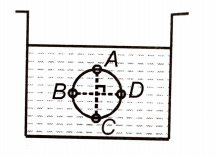Mercury has an angle of contact equal to \(140^\circ\) with soda-lime glass. A narrow tube of radius \(1.00~\text{mm}\) made of this glass is dipped in a trough containing mercury. By what amount does the mercury dip down in the tube relative to the liquid surface outside?
(the surface tension of mercury at the temperature of the experiment is \(0.465~\text{N m}^{–1},\) the density of mercury is \(13.6 × 10^3~\text{kg m}^{–3}\) )
1. \(4.21~\text{mm}\)
2. \(5.34~\text{mm}\)
3. \(3.12~\text{mm}\)
4. \(6.16~\text{mm}\)
(the surface tension of mercury at the temperature of the experiment is \(0.465~\text{N m}^{–1},\) the density of mercury is \(13.6 × 10^3~\text{kg m}^{–3}\) )
1. \(4.21~\text{mm}\)
2. \(5.34~\text{mm}\)
3. \(3.12~\text{mm}\)
4. \(6.16~\text{mm}\)
Two narrow bores of diameters \(3.0 ~\text{mm}\) and \(6.0 ~\text{mm}\) are joined together to form a U-tube open at both ends. If the U-tube contains water, what is the difference in its levels in the two limbs of the tube? (The surface tension of water at the temperature of the experiment is \(7.3\times 10^{-2} ~\text{Nm}^{-1}\). Take the angle of contact to be zero and the density of water to be \(1.0\times 10^{3}~\text{kg m}^{-3}.\)\((g=9.8 ~\text{ms}^{-2})\)
1. \(4.95 ~\text{mm}\)
2. \(3.73 ~\text{mm}\)
3. \(8.91 ~\text{mm}\)
4. \(5.36 ~\text{mm}\)
The term 'fluid' is used for
1. Liquids only
2. Gases only
3. A mixture of liquid and gas only
4. Both liquids and gases
Select wrong statement about pressure
1. Pressure is a scalar quantity
2. Pressure is always compressive in nature
3. Pressure at a point is same in all directions
4. None of these
Gauge pressure
1. May be positive
2. May be negative
3. May be zero
4. All of these
The pressure of confined air is p. If the atmospheric pressure is P, then

1. P is equal to p
2. P is less than p
3. P is greater than p
4. P may be less or greater than p depending on the mass of the confined air
Figure shows a container filled with a liquid of density . Four points A, B, C and D lie on the diametrically opposite points of a circle as shown. Points A and C lie on vertical line and points B and D lie on horizontal line. The incorrect statement is (pA, pB, pC, pD are absolute pressure at the respective points)

1.
2.
3.
4.
The volume of an air bubble is doubled as it rises from the bottom of lake to its surface. The atmospheric pressure is 75 cm of mercury. The ratio of density of mercury to that of lake water is . The depth of the lake in metre is
1. 10
2. 15
3. 20
4. 25
A beaker containing a liquid of density moves up with an acceleration 'a'. The pressure due to the liquid at a depth h below free surface of the liquid is
1.
2.
3.
4.
A barometer kept in an elevator reads 76 cm when it is at rest. If the elevator goes up with some acceleration, the reading will be
1. 76 cm
2. > 76 cm
3. < 76 cm
4. Zero






